服务器网卡多网卡绑定及vlan划分配置方法
划分vlan的四种方法
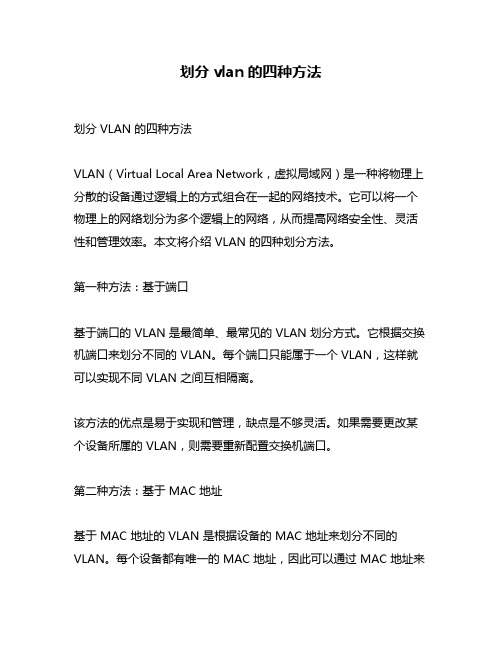
划分vlan的四种方法划分 VLAN 的四种方法VLAN(Virtual Local Area Network,虚拟局域网)是一种将物理上分散的设备通过逻辑上的方式组合在一起的网络技术。
它可以将一个物理上的网络划分为多个逻辑上的网络,从而提高网络安全性、灵活性和管理效率。
本文将介绍 VLAN 的四种划分方法。
第一种方法:基于端口基于端口的 VLAN 是最简单、最常见的 VLAN 划分方式。
它根据交换机端口来划分不同的 VLAN。
每个端口只能属于一个 VLAN,这样就可以实现不同 VLAN 之间互相隔离。
该方法的优点是易于实现和管理,缺点是不够灵活。
如果需要更改某个设备所属的 VLAN,则需要重新配置交换机端口。
第二种方法:基于 MAC 地址基于 MAC 地址的 VLAN 是根据设备的 MAC 地址来划分不同的VLAN。
每个设备都有唯一的 MAC 地址,因此可以通过 MAC 地址来确定设备所属的 VLAN。
该方法可以实现动态加入和移除设备,但也存在一些问题。
例如,如果某个设备更换了网卡,则需要重新配置其所属的 VLAN。
第三种方法:基于子网基于子网的 VLAN 是根据 IP 地址子网来划分不同的 VLAN。
每个子网可以对应一个 VLAN,这样就可以实现跨 VLAN 的通信。
该方法需要在交换机上配置IP 子网,因此需要一定的网络知识和技能。
同时,该方法也存在一些限制,例如无法实现跨子网的广播和多播。
第四种方法:基于协议基于协议的 VLAN 是根据网络协议来划分不同的 VLAN。
例如,可以将所有 VoIP 流量划分到一个 VLAN 中,将所有视频流量划分到另一个 VLAN 中。
该方法可以提高网络性能和管理效率,但也需要一定的网络知识和技能。
同时,该方法也存在一些限制,例如无法对混合流量进行精确控制。
总结以上是四种常见的 VLAN 划分方法。
每种方法都有其优缺点和适用场景。
在实际应用中,需要根据具体情况选择合适的方法,并结合其他网络技术进行综合应用。
双网卡绑定实现就是使用两块网卡虚拟成为一块网卡

双网卡绑定实现就是使用两块网卡虚拟成为一块网卡,这个聚合起来的设备看起来是一个单独的以太网接口设备,通俗点讲就是两块网卡具有相同的IP地址而并行链接聚合成一个逻辑链路工作。
根据交换机可支持的功能不通,最常见的是设定为主备方式的双网卡绑定。
一、操作步骤这里以绑定两个网卡为示例描述。
配置文件都在/etc/sysconfig/network-scripts/目录下。
1、编辑新的ifcfg-bond0文件增加如下内容:引用# cat /etc/sysconfig/network-scripts/ifcfg-bond0DEVICE=bond0IPADDR=192.168.1.155NETMASK=255.255.255.0ONBOOT=yesBOOTPROTO=noneUSERCTL=no这是最后bond0设备的实际IP设置。
2、分别编辑ifcfg-eth0和ifcfg-eth1文件引用# cat /etc/sysconfig/network-scripts/ifcfg-eth0DEVICE=eth0USERCTL=noONBOOT=yesMASTER=bond0SLAVE=yesBOOTPROTO=none# cat /etc/sysconfig/network-scripts/ifcfg-eth1DEVICE=eth1USERCTL=noONBOOT=yesMASTER=bond0SLAVE=yesBOOTPROTO=none3、修改/etc/modules.conf文件# vi /etc/modules.conf添加如下内容:引用alias bond0 bondingoptions bond0 miimon=100 mode=1说明:引用miimon是用来进行链路监测的。
比如:miimon=100,那么系统每100ms监测一次链路连接状态,如果有一条线路不通就转入另一条线路;mode的值表示工作模式,他共有0,1,2,3四种模式,常用的为0,1两种。
vlan的配置方法

vlan的配置方法VLAN(Virtual Local Area Network,虚拟局域网)是一种将一个物理网络划分成多个逻辑上的虚拟网络的技术,它可以提供更好的网络性能、安全性和管理灵活性。
在进行VLAN的配置时,需要按照一定的步骤进行操作,下面将详细介绍VLAN的配置方法。
1. 确定VLAN的划分方案在配置VLAN之前,需要先确定VLAN的划分方案。
可以根据不同的需求和网络拓扑结构,将网络划分为不同的VLAN,如按照部门、功能或地理位置等进行划分。
确定划分方案后,可以开始进行VLAN的配置。
2. 创建VLAN在交换机上创建VLAN是配置VLAN的第一步。
可以通过以下命令在交换机上创建VLAN:```Switch(config)# vlan vlan_id```其中,vlan_id为VLAN的标识符,可以根据实际需求进行设置。
创建VLAN后,可以通过以下命令查看已创建的VLAN列表:```Switch# show vlan```3. 配置接口创建VLAN后,需要将交换机的接口与相应的VLAN进行关联。
可以通过以下命令将接口划分到指定的VLAN:```Switch(config)# interface interface_idSwitch(config-if)# switchport mode accessSwitch(config-if)# switchport access vlan vlan_id```其中,interface_id为接口的标识符,可以是物理接口、端口通道或VLAN接口。
vlan_id为要划分到的VLAN的标识符。
配置完成后,可以通过以下命令查看接口的VLAN配置情况:```Switch# show interfaces interface_id switchport```4. 配置Trunk接口如果需要在不同的交换机之间传输多个VLAN的数据,就需要配置Trunk接口。
vlan划分的基本步骤

vlan划分的基本步骤VLAN(Virtual Local Area Network)是一种逻辑划分网络的技术,通过将不同的网络设备划分到不同的VLAN中,可以实现不同VLAN之间的隔离和互访。
在进行VLAN划分时,需要按照一定的步骤进行,以确保网络的可靠性和稳定性。
下面将介绍以VLAN划分的基本步骤,以帮助读者更好地理解和应用这一技术。
第一步:规划VLAN划分方案在开始进行VLAN划分之前,首先需要明确网络的需求和目标,以确定划分方案。
可以根据部门、功能、地理位置等因素进行划分,也可以根据不同的用户组进行划分。
在规划划分方案时,需要考虑网络的规模、性能要求以及未来的扩展需求。
第二步:配置VLAN在进行VLAN划分之前,需要先配置VLAN。
这包括创建VLAN、分配VLAN ID、配置VLAN接口等操作。
可以通过命令行界面或图形界面来完成配置,具体的配置方法可以参考设备的用户手册或厂商提供的技术文档。
第三步:划分VLAN在完成VLAN的配置后,可以开始进行VLAN的划分。
根据之前规划的方案,将不同的设备或端口划分到相应的VLAN中。
可以通过配置交换机的端口属性来实现设备和端口的划分,也可以通过配置路由器的子接口来实现不同VLAN之间的互访。
第四步:配置VLAN间的互访在完成VLAN的划分后,不同的VLAN之间默认是隔离的,无法相互通信。
如果需要不同VLAN之间的互访,需要进行相应的配置。
可以通过配置交换机的端口属性、配置路由器的子接口或使用三层交换机等方式来实现VLAN间的互访。
第五步:测试和验证在完成VLAN的配置和划分后,需要进行测试和验证,以确保网络的正常运行。
可以通过ping命令或其他网络测试工具来测试不同VLAN之间的连通性和互访性。
如果发现问题,需要及时进行排查和修复。
第六步:管理和维护在VLAN划分完成后,还需要进行管理和维护。
可以通过监控工具来监控VLAN的状态和性能,及时发现和解决问题。
vlan划分实施方案
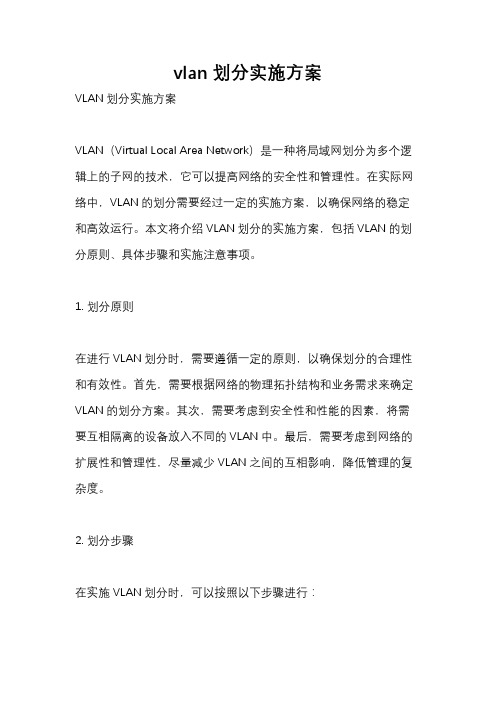
vlan划分实施方案VLAN划分实施方案VLAN(Virtual Local Area Network)是一种将局域网划分为多个逻辑上的子网的技术,它可以提高网络的安全性和管理性。
在实际网络中,VLAN的划分需要经过一定的实施方案,以确保网络的稳定和高效运行。
本文将介绍VLAN划分的实施方案,包括VLAN的划分原则、具体步骤和实施注意事项。
1. 划分原则在进行VLAN划分时,需要遵循一定的原则,以确保划分的合理性和有效性。
首先,需要根据网络的物理拓扑结构和业务需求来确定VLAN的划分方案。
其次,需要考虑到安全性和性能的因素,将需要互相隔离的设备放入不同的VLAN中。
最后,需要考虑到网络的扩展性和管理性,尽量减少VLAN之间的互相影响,降低管理的复杂度。
2. 划分步骤在实施VLAN划分时,可以按照以下步骤进行:第一步,进行网络设备的准备。
包括交换机、路由器等网络设备的准备和连接。
第二步,进行VLAN的划分。
根据划分原则,将网络中的设备划分到不同的VLAN中,可以根据设备的功能、部门、位置等因素进行划分。
第三步,进行VLAN的配置。
在交换机和路由器上进行VLAN的配置,包括VLAN的创建、端口的划分、VLAN间的路由设置等。
第四步,进行VLAN的测试。
在划分和配置完成后,需要进行VLAN 的测试,确保各个VLAN之间的通信正常,网络的性能和安全性符合要求。
3. 实施注意事项在实施VLAN划分时,需要注意以下几点:首先,需要对网络进行充分的调研和规划,确保划分的合理性和有效性。
其次,需要进行详细的文档记录,包括VLAN的划分方案、配置过程、测试结果等,以便日后的管理和维护。
再次,需要进行充分的培训和沟通,确保网络管理员和相关人员对VLAN划分方案的理解和掌握。
最后,需要进行全面的测试和验证,确保VLAN划分的稳定性和安全性。
总结VLAN的划分实施方案是网络管理中的重要环节,它可以提高网络的安全性和管理性,但也需要经过合理的规划和实施。
交换机VLAN的划分和配置方法

交换机VLAN的划分和配置方法VLAN是Virtual Local Network的缩写,翻译为中文就是虚拟局域网。
主要功能是为了减少冲突域、隔离广播域,以及更好地管理上网终端。
交换机vlan工作原理是,数据进入交换机端口时被打上vlan 标记(tag)。
数据从交换机端口发出时,会被去除标记。
而在交换机内部,只有端口的vlan ID包含数据的vlan tag时,才会被转发。
1、VLAN划分方法VLAN划分主要根据其功能来进行划分。
通常可以根据不同的出发点来做不同的划分。
比如:•为了减少部门之间的访问,可以为每个部门规划一个VLAN;•为了管理方便,可以为网络设备的管理单独划分一个VLAN;•为了区分无线网络,可以将无线网络单独划分一个VLAN;•为了区分服务器和终端电脑,可以为服务器单独规划一个VLAN;•为了保障视频监控的网络质量,可以为视频网络单独划分一个VLAN(或者干脆独立一个交换机);•如果单位有计划采用基于802.1x+动态VLAN的策略,那需要规划动态VLAN;•VLAN之间按需开通互相访问,一般情况下通过三层交换机转发。
•划分了多个VLAN的交换机,上行口需规划Trunk模式,允许多VLAN上行;2、VLAN的配置方法配置VLAN属于网络工程师比较基础的工作,配置相对简单。
首先用console线连接交换机的com口,并用secuCRT类似终端软件来进行配置。
这里以思科交换机为例说说配置方法:①、样例:添加VLAN 11,并增加端口1-10到其中c2960S>enPassword:c2960S#conf tc2960S(config)#vlan 11c2960S(config-vlan)#exitc2960S(config)#interface range gigabitEthernet 0/1 -11c2960S(config-if-range)#switchport access vlan 11c2960S(config-if-range)#endc2960S#wr配置更多VLAN,可以依样画葫芦,照着样例配置即可。
vlan的划分方法及配置

vlan的划分方法及配置VLAN的划分方法及配置。
VLAN(Virtual Local Area Network)是一种虚拟局域网技术,通过将网络设备划分成多个逻辑上的局域网,实现不同用户或设备之间的隔离和通信。
VLAN的划分方法及配置对于网络管理和优化至关重要。
本文将介绍VLAN的划分方法及配置,帮助读者更好地理解和应用这一技术。
1. VLAN的划分方法。
VLAN的划分方法主要有基于端口、基于MAC地址和基于协议。
基于端口的划分方法是将交换机的端口划分到不同的VLAN中,实现不同VLAN之间的隔离。
基于MAC地址的划分方法是根据设备的MAC地址将其划分到不同的VLAN中,实现设备级别的隔离。
基于协议的划分方法是根据网络协议将不同类型的流量划分到不同的VLAN中,实现流量级别的隔离。
2. VLAN的配置。
VLAN的配置主要包括VLAN的创建、VLAN的划分和VLAN的配置。
首先,需要在交换机上创建VLAN,并为每个VLAN分配一个唯一的VLAN ID。
然后,将端口划分到相应的VLAN中,实现不同VLAN之间的隔离。
最后,对VLAN进行相应的配置,如VLAN间的路由配置、VLAN的名称和描述配置等。
3. VLAN的划分方法及配置实例。
假设有一个企业网络,需要将不同部门的员工划分到不同的VLAN中,并实现不同VLAN之间的隔离。
首先,可以根据部门的不同创建不同的VLAN,如销售部门、研发部门和市场部门。
然后,将交换机的端口划分到相应的VLAN中,如将销售部门的端口划分到销售部门的VLAN中。
最后,对每个VLAN进行相应的配置,如配置VLAN间的路由、配置VLAN的名称和描述等。
4. 总结。
VLAN的划分方法及配置是企业网络管理中非常重要的一部分,通过合理的划分和配置,可以实现不同用户或设备之间的隔离和通信,提高网络的安全性和可管理性。
在实际应用中,需要根据实际情况选择合适的划分方法,并进行相应的配置,以实现网络的优化和管理。
vlan的划分方法

vlan的划分方法方法一:基于功能的划分根据网络中各设备的功能需求和通信需求,将网络划分为不同的VLAN。
不同的功能可以包括不同的用户群或应用程序,例如管理部门、销售部门、访客、VoIP电话等。
每个VLAN 可以通过交换机端口或MAC地址与一个特定的功能或部门相关联。
方法二:基于物理位置的划分根据设备的物理位置将网络划分为不同的VLAN。
这种方法可以帮助提高网络的安全性和管理性,因为每个VLAN可以更好地控制物理位置。
例如,可以根据不同的建筑物、不同的楼层或不同的机房将设备划分到不同的VLAN。
方法三:基于安全性的划分根据网络中不同设备的安全级别,将网络划分为不同的VLAN。
这种方法可以帮助隔离不同安全级别的设备,防止安全漏洞对整个网络产生影响。
例如,可以将防火墙、入侵检测系统和其他安全设备与关键服务器分配到一个高安全级别的VLAN,将普通用户设备与非关键服务器分配到一个较低安全级别的VLAN。
方法四:基于应用的划分根据网络中不同应用程序的需求,将网络划分为不同的VLAN。
这种方法可以优化网络性能并降低网络拥塞。
例如,可以将视频流量、音频流量、数据流量等划分到不同的VLAN,以保证每个应用程序有足够的带宽和资源。
方法五:基于设备类型的划分根据网络中不同设备的类型和特性,将网络划分为不同的VLAN。
这种方法可以方便设备管理和故障隔离。
例如,可以将路由器、交换机、服务器和无线接入点等设备分配到不同的VLAN,以便针对不同类型的设备进行管理和故障排除。
请注意,VLAN的划分方法可以根据实际网络需求进行组合或灵活调整,以满足特定网络环境的要求。
vlan常见划分方式

vlan常见划分方式VLAN(Virtual Local Area Network)是一种虚拟局域网技术,可以将一个物理局域网划分成多个逻辑上的虚拟局域网,实现网络资源的灵活管理和分配。
在实际应用中,可以根据不同的需求和网络拓扑结构,采用不同的VLAN划分方式。
下面将介绍几种常见的VLAN划分方式。
一、基于端口的VLAN划分基于端口的VLAN划分是最简单和最常见的VLAN划分方式。
在这种方式下,交换机的每个端口都会被划分到不同的VLAN中,不同VLAN之间相互隔离。
这种划分方式适用于规模较小的局域网,可以根据实际需求,将不同部门、不同用户或不同功能的设备划分到不同的VLAN中,实现网络资源的隔离和管理。
二、基于MAC地址的VLAN划分基于MAC地址的VLAN划分是根据设备的MAC地址来进行划分的一种方式。
每个设备都有唯一的MAC地址,可以通过交换机的配置,将不同MAC地址的设备划分到不同的VLAN中。
这种划分方式可以实现对特定设备的精确控制,例如将特定的服务器或特定的终端设备划分到不同的VLAN中,以实现更加细粒度的网络资源管理。
三、基于子网的VLAN划分基于子网的VLAN划分是根据IP地址的子网来进行划分的一种方式。
在这种方式下,可以将不同的IP子网划分到不同的VLAN中,实现对不同子网的隔离和管理。
这种划分方式适用于规模较大的网络环境,可以根据不同的子网需求,将其划分到不同的VLAN中,提高网络的可管理性和安全性。
四、基于协议的VLAN划分基于协议的VLAN划分是根据数据包的协议类型来进行划分的一种方式。
在这种方式下,可以根据不同的网络协议将数据包划分到不同的VLAN中,实现对不同协议的隔离和管理。
例如,可以将IP数据包和IPX数据包划分到不同的VLAN中,实现对不同协议的优化和管理。
五、基于策略的VLAN划分基于策略的VLAN划分是根据用户的身份或角色来进行划分的一种方式。
在这种方式下,可以根据用户的身份或角色将其划分到不同的VLAN中,实现对不同用户的隔离和管理。
双网卡绑定NCU软件的详细功能以及使用

NFT(Network Fault Tolerant):这种模式下一个网口处于Active状态,另外一个网口处于Standby状态,可以把2个网线连接到不同的交换机上面达到容错目的。
在NFT之外还有一种是Network Fault Tolerance with Preference Order模式,该模式为NFT的增强版。就是带有优先级的NFT模式,比如服务器分别连接到2台交换机上,一台交换机为千兆,一台交换机为百兆。那么连接千兆交换机的网口为Active状态,连接百兆交换机的网口为Standby状态。
目前VLAN 200中的笔记本是无法ping通的
在NCU工具中选中网口1,之后点击VLAN(802.1Q)按钮
出现如下窗口,点击ADD选项,添加VLAN
在VLAN Properties中添加本地网口接入的VLAN 2该VLAN默认为Native Vlan
添加笔记本所在的VLAN 100
可以看到网口1前面出现一个V的图标,说明已经设置网口跨VLAN。
双网卡绑定NCU软件的详细功能以及使用
———————————————————————————————— 作者:
———————————————————————————————— 日期:
NCU软件的详细功能以及使用
设备:DL380 G5 +HP ProCurve 2510交换机
Contents
NCU软件简介
由于交换机端默认开启的是被动协商,所以当设置802.3ad Dynamic模式后网络连接被断开
查看Team Utilization中可以看到RX和TX都为0bps
当手动将交换机上网卡接入的端口开启LACP主动协商模式后,网卡状态变成正常工作状态。
网卡绑定(多网卡绑定成一个虚拟网卡负载均衡)

网卡绑定,就将两个或者更多的物理网卡绑定成一个虚拟网卡,以提供负载均衡或者冗余,能够起到增加带宽的作用;当网卡绑定之后,如果有一个网卡坏掉,网络会继续保持,不会中断,从而不会影响业务。
Windows下网卡绑定Windows 下进行网卡绑定,需要根据网卡的类型下载网卡驱动,通过网卡驱动进行网卡绑定。
设备:HS22,BCE刀箱系统:windows 2008 Enterprise R2 x64网卡类型:首先下载网卡驱动,在驱动的MgmtApps文件夹下,寻找符合系统要求的setup.exe文件,双击击安装。
在接受许可条例之后,进入自定义安装界面,如下:我们这里只安装BASP,直接下一步。
安装结束后,会提醒你从控制面板中找到,这里,我们只要打开开始菜单就可以看见新安装的BACS软件了。
(注意,如果是intel的网卡,系统会默认图标显示在控制面板中。
)软件界面如下:界面左侧的Device Management,显示的是主机当前的网卡,Team Management是用来对网卡绑定进行操作和管理的。
右边是动态展示栏,可以展示每块网卡的信息(Information),可以通过自动ping网卡IP,诊断网卡当前状态(Diagnostics),还可以统计网卡活动状态(Statistics)。
网卡绑定,在实际操作中,是采用虚拟网卡组的概念,将现有网卡,绑定成一个虚拟网卡组。
因此在BACS中,我们打开Team Management来进行网卡绑定。
打开Team Management,左侧看到的是可以进行绑定的网卡状态。
我们打开上层菜单栏中的“Teams”,选择“Create a team”,就进入了网卡绑定的引导界面。
选择“Next”。
首先输入一个网卡绑定组的名字:选择“Next”进入类型界面。
Broadcom网卡绑定有三种类型,--Smart Load Balancing(TM)and Failover(SLB):智能负载均衡和故障转移。
Windows网卡配置VLANID

Windows⽹卡配置VLANID
修改为对应的值即可:
Windows ⽹卡配置多VLAN
⽬前测试⽀持的是Intel⽹卡
微软PROSet驱动安装:
下载地址:
根据电脑操作系统选择适合的版本进⾏安装,⽹卡属性⾥有红框项表⽰安装成功
1. 设置⽹卡
右键点击有线⽹卡,属性—》配置—》VLAN,若没有此栏请检查PROSet软件是否安装正确
点击新建VLAN,若交换机有24个⼝⼦,则新建23个VLAN,例如从100到123
2. 设置IP地址。
查看⽹络连接,会出现多个带VLAN的⽹卡,依次为每个VLAN⽹卡配置IPV4地址,地址与ONU IP同⽹段,例如从 192.168.1.100 配到192.168.1.123。
3. 配置交换机(以24⼝交换机为例)
交换机1到23号⼝依次配置为ACCESS模式,ACCESS VLAN依次从100配到123,与电脑⽹卡配置的VLAN⼀⼀对应。
交换机24号⼝配置trunk模式,允许VLAN 100到123通过。
4. 连接PC与交换机和ONU
将电脑连接到交换机第24⼝。
ONU依次接在交换机1到23⼝
5. 测试环境搭建是否OK
⽤带源地址PING ONU,源地址从192.168.1.100到192.168.1.123
例ping 192.168.1.1 -S 192.168.1.100,所有地址能PING则正常。
vlan的配置方法
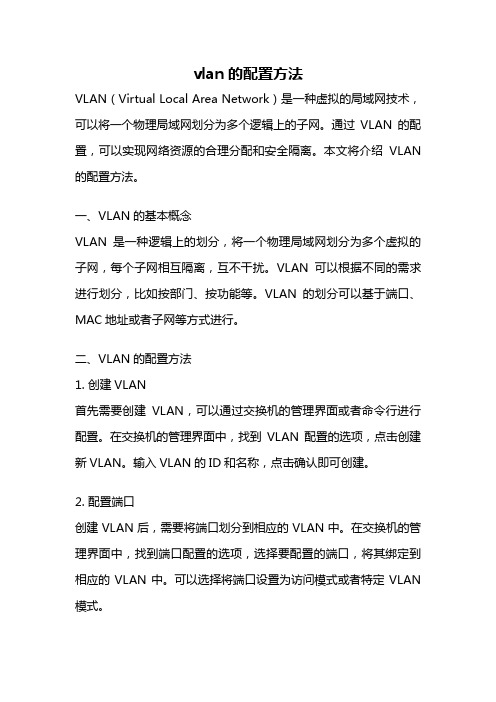
vlan的配置方法VLAN(Virtual Local Area Network)是一种虚拟的局域网技术,可以将一个物理局域网划分为多个逻辑上的子网。
通过VLAN的配置,可以实现网络资源的合理分配和安全隔离。
本文将介绍VLAN 的配置方法。
一、VLAN的基本概念VLAN是一种逻辑上的划分,将一个物理局域网划分为多个虚拟的子网,每个子网相互隔离,互不干扰。
VLAN可以根据不同的需求进行划分,比如按部门、按功能等。
VLAN的划分可以基于端口、MAC地址或者子网等方式进行。
二、VLAN的配置方法1. 创建VLAN首先需要创建VLAN,可以通过交换机的管理界面或者命令行进行配置。
在交换机的管理界面中,找到VLAN配置的选项,点击创建新VLAN。
输入VLAN的ID和名称,点击确认即可创建。
2. 配置端口创建VLAN后,需要将端口划分到相应的VLAN中。
在交换机的管理界面中,找到端口配置的选项,选择要配置的端口,将其绑定到相应的VLAN中。
可以选择将端口设置为访问模式或者特定VLAN 模式。
3. 配置端口模式端口模式分为访问模式和特定VLAN模式。
访问模式下,端口只能属于一个VLAN,数据包只能在该VLAN中传输。
特定VLAN模式下,端口可以属于多个VLAN,数据包可以在多个VLAN之间传输。
根据需求选择相应的端口模式。
4. 配置VLAN间的互通不同VLAN之间默认是隔离的,无法直接通信。
如果需要实现不同VLAN之间的互通,可以通过三层交换机或者路由器进行配置。
在交换机或者路由器上配置虚拟接口,将不同VLAN的虚拟接口进行绑定,即可实现VLAN间的互通。
5. 配置VLAN间的安全为了增强网络的安全性,可以配置VLAN间的访问控制列表(ACL)或者端口安全。
ACL可以限制不同VLAN之间的通信,只允许特定的IP地址或者端口进行通信。
端口安全可以限制端口上的设备数量,防止未授权设备接入。
6. 配置VLAN的管理在配置VLAN时,还需要考虑VLAN的管理。
了解VLAN网络配置

了解VLAN网络配置VLAN网络配置简介VLAN(Virtual Local Area Network)是一种将物理网络划分成多个逻辑上独立的虚拟网络的技术。
通过VLAN,可以将不同的主机和设备分组在不同的虚拟网络中,实现安全隔离和逻辑隔离。
本文将介绍VLAN网络的配置方法和相关概念。
一、VLAN的基本概念VLAN是一种逻辑划分网络的方法,将一个物理局域网分割成多个虚拟局域网。
每个VLAN都有一个唯一的标识符(VLAN ID),用于区分不同的虚拟网络。
VLAN可以跨越多个交换机,实现虚拟网络的扩展和连接。
二、VLAN的配置方式1. VLAN的创建在配置VLAN之前,需要先创建VLAN。
在交换机的命令行界面,使用创建VLAN的命令,例如:```Switch(config)# vlan 10Switch(config-vlan)# name Sales```上述命令创建了一个ID为10的VLAN,并设置它的名称为"Sales"。
2. VLAN的端口成员配置创建VLAN后,需要将交换机上的端口分配到对应的VLAN中。
可以通过以下命令将端口加入VLAN:```Switch(config)# interface gigabitethernet 1/0/1Switch(config-if)# switchport mode accessSwitch(config-if)# switchport access vlan 10```上述命令将交换机上的GigabitEthernet 1/0/1端口配置为访问模式,并将它加入到VLAN 10中。
3. 端口的Trunk配置如果需要通过一个交换机传输多个VLAN的数据,需要将交换机端口配置为Trunk模式。
Trunk可以在VLAN之间传递数据帧,实现VLAN的连接。
配置Trunk的命令如下:```Switch(config)# interface gigabitethernet 1/0/2Switch(config-if)# switchport mode trunk```上述命令将交换机上的GigabitEthernet 1/0/2端口配置为Trunk模式。
服务器网卡绑定操作

服务器网卡绑定操作服务器网卡绑定操作是一种常见的网络优化技术,通过将多个网卡绑定成一个虚拟接口,提供更高的网络吞吐量和可靠性。
本文将介绍服务器网卡绑定操作的原理和常用的绑定方式,以及相关的配置和管理技巧。
一、绑定原理服务器网卡绑定操作的原理基于网络负载均衡和冗余备份的需求。
通过将多个物理网卡绑定成一个逻辑网卡,实现数据在多个网卡之间的均衡传输,提升服务器网络性能。
同时,当其中一个网卡故障时,其他网卡可以自动接管数据传输,保证网络的可靠性。
二、绑定方式1. 适配器绑定模式适配器绑定模式是最常用的绑定方式,将多个网卡绑定为一个逻辑网卡,实现负载均衡和冗余备份。
该模式分为两种类型:- 轮询模式:轮询模式会将传入的请求依次分发到每个网卡上,实现负载均衡。
但是由于网卡带宽和性能的不同,可能会导致某个网卡负载较高。
- 适配器故障转移模式:适配器故障转移模式在主用网卡发生故障时,会自动将数据流量切换到备用网卡,保证网络的可靠性。
2. 链路聚合模式链路聚合模式将多个网卡绑定为一个逻辑网卡,并通过链路聚合控制协议(LACP)实现对网络流量的负载均衡和冗余备份。
该模式依赖于网络交换机的支持,通过交换机上的聚合组实现网卡的绑定和控制。
三、配置和管理服务器网卡绑定操作的配置和管理通常需要在服务器的操作系统中进行,以下是一些常用的配置和管理技巧:1. 操作系统支持首先要确保服务器的操作系统支持网卡绑定操作。
大部分现代操作系统,如Linux、Windows Server等,都提供了丰富的网络绑定功能和管理工具。
2. 硬件检查在进行网卡绑定操作之前,要确保服务器的硬件和网络环境满足要求。
检查网卡的型号和规格,以及交换机的配置和支持情况。
3. 配置文件修改根据服务器操作系统的不同,可以通过修改相应的配置文件来实现网卡绑定。
比如在Linux系统中,可以编辑网络配置文件(如/etc/network/interfaces)来指定绑定方式和参数。
服务器网卡多网卡绑定及vlan划分配置方法
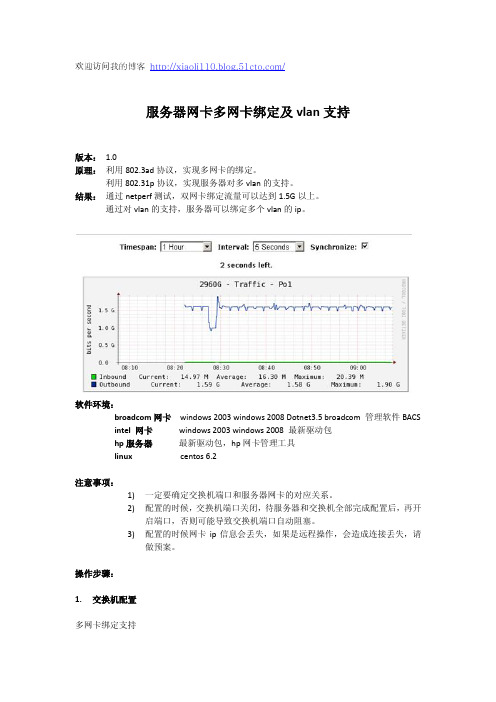
输入一个名字 选择第二项 802.3ad
添加要绑定的网卡 配置 vlan,一般没有的,跳过
完成 需要几分钟的配置
网卡需要几分钟和交换机协商,完成后,可以看到两块网卡开始正常工作
intel 网卡 选择网卡属性
选择分组—将此适配器与其他适配器组合—新组
选择网卡
创建成功,将 Ip 绑定到新建的组上。
附 2: Linux 系统中绑定失败的处理一例 insmod /lib/modules/2.6.18-164.el5/kernel/net/ipv6/ipv6.ko disable=1 insmod /lib/modules/2.6.18-164.el5/kernel/drivers/net/bonding/bonding.ko
snda-intel-lab-2960s-250#sh running-config int g0/4 Building configuration...
Current configuration : 137 bytes ! interface GigabitEthernet0/4
switchport mode access spanning-tree portfast channel-protocol lacp channel-group 1 mode passive end
[root@lab]# cat ifcfg-eth1.100 DEVICE=eth1.100 ONBOOT=yes BOOTPROTO=none TYPE=Ethernet VLAN=yes IPADDR=*.*.*.* NETMASK=255.255.255.0
附 1: Linux 系统中参数及其意义 mode=<value> Allows you to specify the bonding policy. The <value> can be one of:
vlan的划分方法

vlan的划分方法虚拟局域网(VLAN)是一种将局域网划分成多个逻辑上的子网的技术,它可以将不同物理位置的设备通过网络连接在一起,实现统一管理和配置。
VLAN的划分方法有多种,下面将逐一介绍。
1. 基于端口的VLAN划分。
基于端口的VLAN划分是最简单的一种方法,它将交换机的端口划分为不同的VLAN,每个端口只能属于一个VLAN。
这种划分方法适合于一些小型网络,管理和配置比较简单,但对于大型网络来说,会导致管理不便和资源浪费。
2. 基于MAC地址的VLAN划分。
基于MAC地址的VLAN划分是根据设备的MAC地址来确定其所属的VLAN,这样可以实现设备漫游时自动切换到对应的VLAN,提高了网络的灵活性和可管理性。
但是这种方法需要交换机具备MAC地址表,并且需要不断更新和管理MAC地址表,增加了网络的负担。
3. 基于IP地址的VLAN划分。
基于IP地址的VLAN划分是根据设备的IP地址来确定其所属的VLAN,这种方法可以实现对不同子网的划分,提高了网络的安全性和管理效率。
但是需要网络管理员对IP地址进行管理和分配,而且需要交换机支持IP路由功能。
4. 基于协议的VLAN划分。
基于协议的VLAN划分是根据数据包中的协议类型来确定其所属的VLAN,这种方法可以实现对不同协议的划分,提高了网络的性能和管理效率。
但是需要交换机支持协议识别功能,并且需要对协议进行管理和配置。
5. 动态VLAN划分。
动态VLAN划分是根据用户认证信息来确定其所属的VLAN,这种方法可以实现对不同用户的划分,提高了网络的安全性和管理效率。
但是需要交换机支持802.1X认证功能,并且需要配合认证服务器进行管理和配置。
总结。
不同的VLAN划分方法适用于不同的网络环境和需求,网络管理员需要根据实际情况选择合适的方法来进行划分。
在实际应用中,也可以结合多种方法来实现更灵活和高效的VLAN划分。
希望以上内容能够帮助您更好地理解VLAN的划分方法,提高网络管理和配置的效率。
配置vlan的方法

配置vlan的方法配置VLAN(Virtual Local Area Network)的方法是将网络设备按照功能或者部门划分为不同的虚拟网络,从而提高网络性能和安全性。
下面是一些配置VLAN的基本方法。
1. 网络规划和设计:在配置VLAN之前,必须进行网络规划和设计。
这包括确定需要划分的VLAN 数量,每个VLAN所涵盖的网络设备范围,以及设备之间的互联方式。
此外,还需要考虑IP地址分配和子网掩码设置,以确保VLAN之间的互联和通信。
2. VTP(VLAN Trunking Protocol)设置:VTP是一种用于自动配置和管理VLAN的协议。
它包括服务器模式、客户端模式和透明模式。
配置VTP服务器模式的交换机可以管理和分发VLAN信息,而VTP客户端模式的交换机则接收和配置来自VTP服务器模式的信息。
配置VTP 透明模式的交换机不会传递VLAN信息,而只会接收和配置自己的VLAN。
3. VLAN的创建和配置:在交换机上创建和配置VLAN是非常重要的一步。
可以使用命令行界面(CLI)或者图形用户界面(GUI)来进行配置。
在命令行界面下,可以使用"vlan database"命令进入VLAN数据库模式,然后使用"vlan"命令来创建和配置VLAN。
在图形用户界面下,可以通过交换机的管理界面找到VLAN设置并进行配置。
4. VLAN端口配置:一旦VLAN创建和配置完成,还需要将交换机的端口分配给相应的VLAN。
这可以通过命令行界面或者图形用户界面来实现。
在命令行界面下,可以使用"switchport access vlan"命令将端口配置为特定的VLAN。
在图形用户界面下,可以选择相应的端口并将其分配给目标VLAN。
5. VLAN间的通信设置:默认情况下,不同VLAN之间的通信是被禁止的,因此需要进行相应的设置来实现VLAN间的通信。
可以使用三层交换机或者路由器来实现VLAN间的互联。
服务器双网卡配置方法
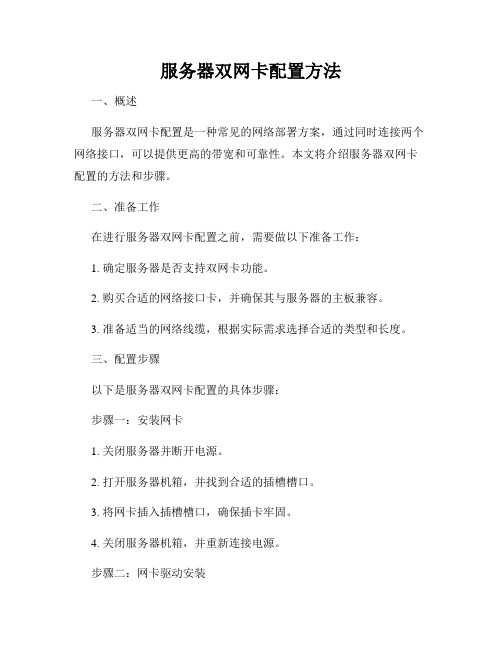
服务器双网卡配置方法一、概述服务器双网卡配置是一种常见的网络部署方案,通过同时连接两个网络接口,可以提供更高的带宽和可靠性。
本文将介绍服务器双网卡配置的方法和步骤。
二、准备工作在进行服务器双网卡配置之前,需要做以下准备工作:1. 确定服务器是否支持双网卡功能。
2. 购买合适的网络接口卡,并确保其与服务器的主板兼容。
3. 准备适当的网络线缆,根据实际需求选择合适的类型和长度。
三、配置步骤以下是服务器双网卡配置的具体步骤:步骤一:安装网卡1. 关闭服务器并断开电源。
2. 打开服务器机箱,并找到合适的插槽槽口。
3. 将网卡插入插槽槽口,确保插卡牢固。
4. 关闭服务器机箱,并重新连接电源。
步骤二:网卡驱动安装1. 启动服务器,并等待操作系统启动完成。
2. 插入网卡驱动光盘或者下载最新的驱动程序。
3. 打开设备管理器,找到新安装的网卡设备。
4. 右键点击网卡设备,选择“更新驱动程序”。
5. 选择“浏览计算机以查找驱动程序”或者“从列表中选择已安装的驱动程序”。
6. 浏览到光盘或者指定的驱动程序文件夹,安装合适的驱动程序。
步骤三:配置网络参数1. 进入操作系统的网络设置界面。
2. 找到新安装的网卡设备,并双击打开其属性窗口。
3. 在属性窗口中,配置合适的IP地址、子网掩码、默认网关和DNS服务器等网络参数。
4. 配置完成后,点击“确定”保存设置。
步骤四:网络绑定1. 打开控制面板,找到“网络和共享中心”。
2. 在左侧导航栏中,选择“更改适配器设置”。
3. 找到新安装的网卡设备,同时按住“Ctrl”键选中其他需要绑定的网卡设备。
4. 右键点击选中的网卡设备,选择“桥接连接”或者“合并网络连接”。
5. 等待网络绑定完成。
四、测试和优化配置完成后,可以进行以下测试和优化步骤:1. 测试网络连接:通过PING命令等方式测试服务器与其他设备之间的网络连通性。
2. 负载均衡优化:根据实际需求和网络流量情况,调整网卡的负载均衡策略,以提高网络性能和可靠性。
vlan分配技巧

vlan分配技巧
VLAN(虚拟局域网)是在物理网络基础上的逻辑划分,可以将不同的网络设备分配到不同的VLAN中,实现网络资源的分离和管理。
下面是VLAN分配技巧的解释:
1. 确定VLAN的数量和功能:在分配VLAN时,首先需要确定所需的VLAN数量和每个VLAN的功能,比如将不同部门的设备放在不同的VLAN中,或者将重要设备放在单独的VLAN中,以提高网络的安全性和性能。
2. 划分IP地址段:在VLAN分配过程中,需要为每个VLAN分配独立的IP地址段,以确保不同VLAN之间的数据不会冲突。
通常情况下,每个VLAN都会有自己的网关地址。
3. 配置端口和交换机:在将设备分配到VLAN之前,需要在交换机上配置VLAN,并将不同端口与对应的VLAN关联起来。
这样,当设备连接到端口时,交换机就会将其自动分配到正确的VLAN中。
4. 管理VLAN:在VLAN分配完成后,需要对其进行管理和监控。
例如,可以使用VLAN间的ACL(访问控制列表)来限制不同VLAN之间的数据通信,也可以使用VLAN间的QoS(服务质量)设置来优化不同VLAN的网络性能。
总之,VLAN分配是一个需要谨慎考虑的过程,需要以实际需求为基础,结合网络拓扑和设备布局来确定VLAN的数量和功能,并根据需要进行管理和优化。
- 1、下载文档前请自行甄别文档内容的完整性,平台不提供额外的编辑、内容补充、找答案等附加服务。
- 2、"仅部分预览"的文档,不可在线预览部分如存在完整性等问题,可反馈申请退款(可完整预览的文档不适用该条件!)。
- 3、如文档侵犯您的权益,请联系客服反馈,我们会尽快为您处理(人工客服工作时间:9:00-18:30)。
Current configuration : 55 bytes ! interface Port-channel1
switchport mode access end
vlan 支持,交换机接服务器端口做 truak 配置
interface GigabitEthernet0/15 switchport mode trunk
2. 软件安装 Windows 系统
1) intel 网卡在 intel 网站下载最新的网卡驱动安装就可以。
2) broadcom 网卡在 broadcom 网站下载最新驱动,并下载网卡管理工具,目前能下载到 的管理工具只支持 windows server 2008,如果需要支持 windows server 2003 请在 dell ibm 等厂家网站支持页面下载比较老的版本。
TYPE=Ethernet MASTER=bond0 SLAVE=yes [root@lab]# cat /etc/modprobe.d/bond0.conf alias bond0 bonding 4. 配置网卡对 vlan 的支持 Windows 系统 Intel 网卡 选择网络连接属性---网卡配置
[root@lab]# cat ifcfg-eth1.100 DEVICE=eth1.100 ONBOOT=yes BOOTPROTO=none TYPE=Ethernet VLAN=yes IPADDR=*.*.*.* NETMASK=255.255.255.0
附 1: Linux 系统中参数及其意义 mode=<value> Allows you to specify the bonding policy. The <value> can be one of:
Linux 系统 [root@lab]# cat /etc/sysconfig/network-scripts/ifcfg-bond0 DEVICE=bond0 BOOTPROTO=none IPADDR=172.16.1.248 NETMASK=255.255.255.0 GATEWAY=172.16.1.1 TYPE=Ethernet BONDING_OPTS="mode=4 miimon=100"
balance-rr or 0 — Sets a round-robin policy for fault tolerance and load balancing. Transmissions are received and sent out sequentially on each bonded slave interface beginning with the first one available. active-backup or 1 — Sets an active-backup policy for fault tolerance. Transmissions are received and sent out via the first available bonded slave interface. Another bonded slave interface is only used if the active bonded slave interface fails. balance-xor or 2 — Sets an XOR (exclusive-or) policy for fault tolerance and load balancing. Using this method, the interface matches up the incoming request's MAC address with the MAC address for one of the slave NICs. Once this link is established, transmissions are sent out sequentially beginning with the first available interface. broadcast or 3 — Sets a broadcast policy for fault tolerance. All transmissions are sent on all slave interfaces. 802.3ad or 4 — Sets an IEEE 802.3ad dynamic link aggregation policy. Creates aggregation groups that share the same speed and duplex settings. Transmits and receives on all slaves in the active aggregator. Requires a switch that is 802.3ad compliant. balance-tlb or 5 — Sets a Transmit Load Balancing (TLB) policy for fault tolerance and load balancing. The outgoing traffic is distributed according to the current load on each slave interface. Incoming traffic is received by the current slave. If the receiving slave fails, another slave takes over the MAC address of the failed slave. balance-alb or 6 — Sets an Active Load Balancing (ALB) policy for fault tolerance and load balancing. Includes transmit and receive load balancing for IPV4 traffic. Receive load balancing is achieved through ARP negotiation.
snda-intel-lab-2960s-250#sh running-config int g0/4 Building configuration...
Current configuration : 137 bytes ! interface GigabitEthernet0/4
switchport mode access spanning-tree portfast channel-protocol lacp channel-group 1 mode passive end
3)
一定要确定交换机端口和服务器网卡的对应关系。 配置的时候,交换机端口关闭,待服务器和交换机全部完成配置后,再开 启端口,否则可能导致交换机端口自动阻塞。 配置的时候网卡 ip 信息会丢失,如果是远程操作,会造成连接丢失,请 做预案。
操作步骤:
1. 交换机配置
多网卡绑定支持
假设 3,4 端口做 port-channel,相关配置如下:
snda-intel-lab-2960s-250#sh running-config int g0/3 Building configuration...
Current configuration : 137 bytes ! interface GigabitEthernet0/3
switchport mode access spanning-tree portfast channel-protocol lacp channel-group 1 mode passive end
软件环境:
broadcom 网卡 windows 2003 windows 2008 Dotnet3.5 broadcom 管理软件 BACS
intel 网卡
windows 2003 windows 2008 最新驱动包
hp 服务器
最新驱动包,hp 网卡管理工具
linux
centos 6.2
注意事项: 1) 2)
3) hp 服务器安装最新的网卡驱动和管理工具,hp 的设置方法和 broadcom 设置类似,多 网卡绑定介绍 broadcom 管理工具使用,网卡 vlan 介绍 hp 网卡的使用。
Linux 系统不需要安装特殊软件 3. 配置网卡端口绑定 Windows 系统 broadcom 网卡 添加一个端口组
欢 访问
服务器网卡多网卡绑定及 vlan 支持
版本: 1.0 原理: 利用 802.3ad 协议,实现多网卡的绑定。
利用 802.31p 协议,实现服务器对多 vlan 的支持。 结果: 通过 netperf 测试,双网卡绑定流量可以达到 1.5G 以上。
通过对 vlan 的支持,服务器可以绑定多个 vlan 的 ip。
添加一个 vlan100
等待配置生效
完成后可以看到生成一个网卡,vlan100,如果需要生成多个 vlan,可以重复操作:
Linux 系统 配置对 vlan100 的支持 [root@lab]# cat ifcfg-eth1 DEVICE=eth1 HWADDR=E4:1F:13:B7:8F:56 ONBOOT=yes BOOTPROTO=none TYPE=Ethernet
[root@lab]# cat /etc/sysconfig/network-scripts/ifcfg-eth0 DEVICE=eth0 BOOTPROTO=none ONBOOT=yes TYPE=Ethernet MASTER=b /etc/sysconfig/network-scripts/ifcfg-eth1 DEVICE=eth1 ONBOOT=yes BOOTPROTO=none
